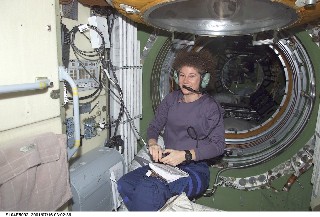
NASA photo of U.S. astronaut Susan J. Helms, KC7NHZ, Expedition Two flight engineer, the first U.S. military woman in space, talking with Amateur Radio operators on Earth on July 16, 2001, from the Amateur Radio station in the Zarya module of the International Space Station (ISS). Click image for larger picture.
Nine years later, in 2010, Lt. General Susan Helms was appointed Commander, 14th Air Force (Air Forces Strategic-Space), Air Force Space Command; and Commander, Joint Functional Component Command for Space, U.S. Strategic Command, Vandenberg Air Force Base, California.
More pictures >>